key TOYOTA GT86 2012 Owner's Manual
[x] Cancel search | Manufacturer: TOYOTA, Model Year: 2012, Model line: GT86, Model: TOYOTA GT86 2012Pages: 448, PDF Size: 13.47 MB
Page 51 of 448
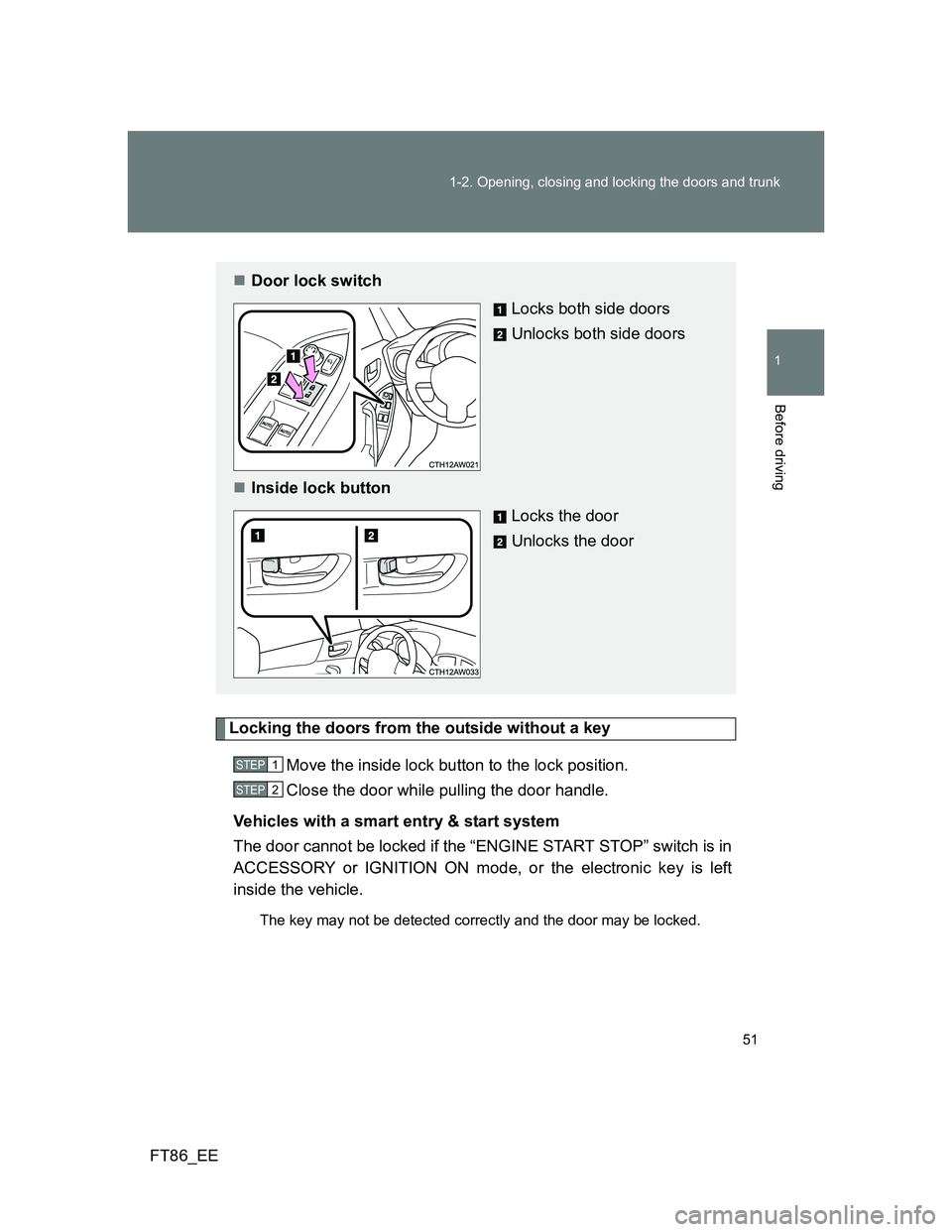
51 1-2. Opening, closing and locking the doors and trunk
1
Before driving
FT86_EE
Locking the doors from the outside without a key
Move the inside lock button to the lock position.
Close the door while pulling the door handle.
Vehicles with a smart entry & start system
The door cannot be locked if the “ENGINE START STOP” switch is in
ACCESSORY or IGNITION ON mode, or the electronic key is left
inside the vehicle.
The key may not be detected correctly and the door may be locked.
Door lock switch
Locks both side doors
Unlocks both side doors
Inside lock button
Locks the door
Unlocks the door
STEP 1
STEP 2
Page 52 of 448
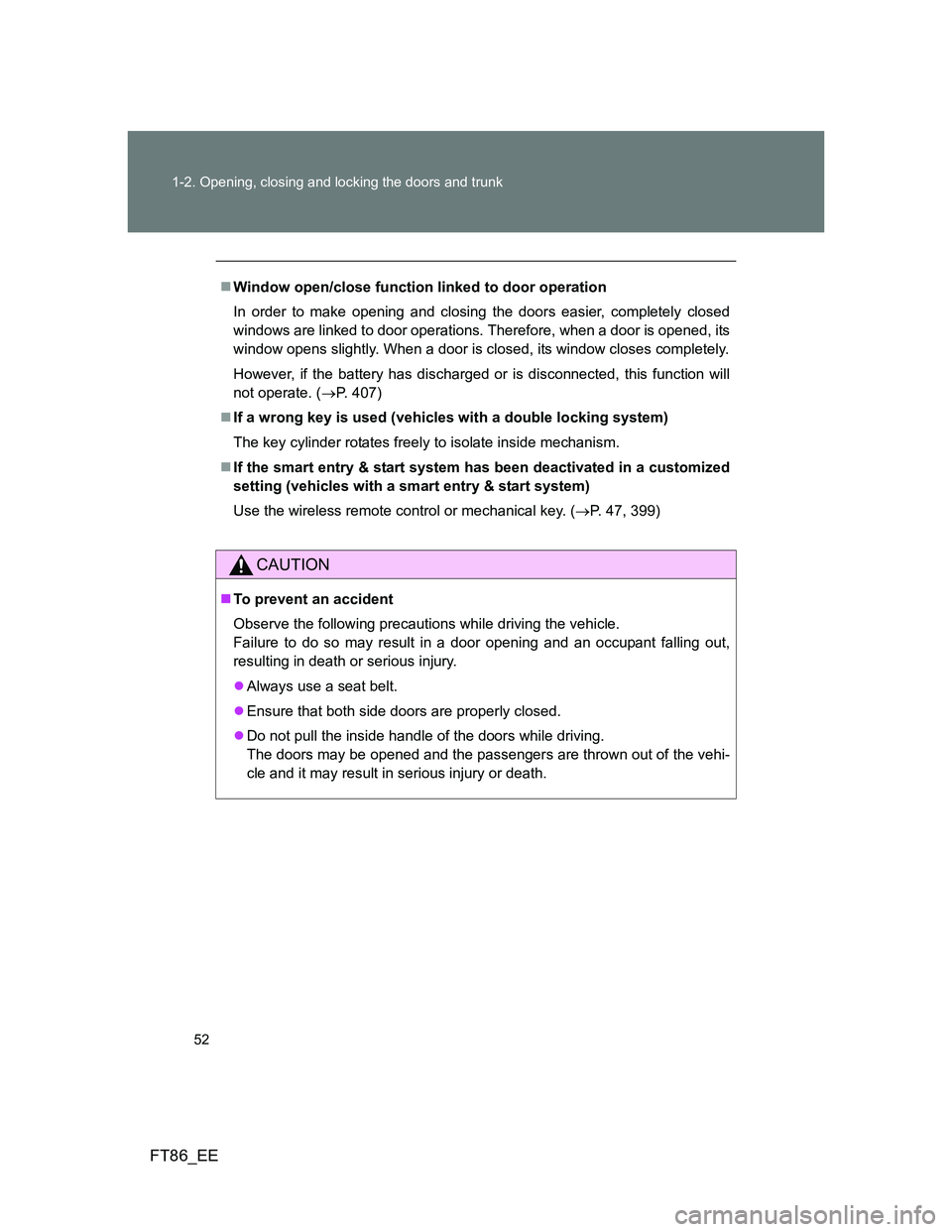
52 1-2. Opening, closing and locking the doors and trunk
FT86_EE
Window open/close function linked to door operation
In order to make opening and closing the doors easier, completely closed
windows are linked to door operations. Therefore, when a door is opened, its
window opens slightly. When a door is closed, its window closes completely.
However, if the battery has discharged or is disconnected, this function will
not operate. (P. 407)
If a wrong key is used (vehicles with a double locking system)
The key cylinder rotates freely to isolate inside mechanism.
If the smart entry & start system has been deactivated in a customized
setting (vehicles with a smart entry & start system)
Use the wireless remote control or mechanical key. (P. 47, 399)
CAUTION
To prevent an accident
Observe the following precautions while driving the vehicle.
Failure to do so may result in a door opening and an occupant falling out,
resulting in death or serious injury.
Always use a seat belt.
Ensure that both side doors are properly closed.
Do not pull the inside handle of the doors while driving.
The doors may be opened and the passengers are thrown out of the vehi-
cle and it may result in serious injury or death.
Page 53 of 448
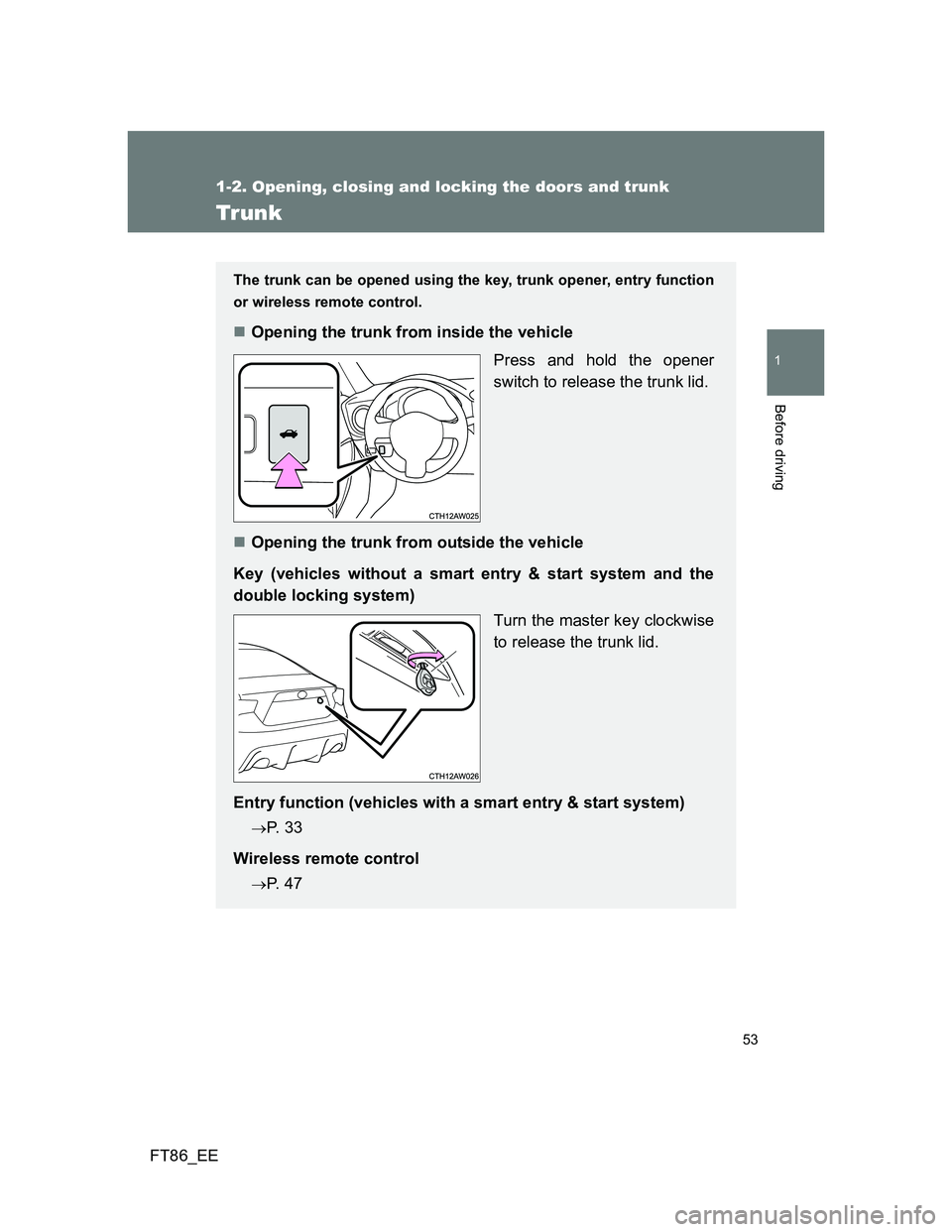
53
1
1-2. Opening, closing and locking the doors and trunk
Before driving
FT86_EE
Trunk
The trunk can be opened using the key, trunk opener, entry function
or wireless remote control.
Opening the trunk from inside the vehicle
Press and hold the opener
switch to release the trunk lid.
Opening the trunk from outside the vehicle
Key (vehicles without a smart entry & start system and the
double locking system)
Turn the master key clockwise
to release the trunk lid.
Entry function (vehicles with a smart entry & start system)
P. 3 3
Wireless remote control
P. 4 7
Page 54 of 448
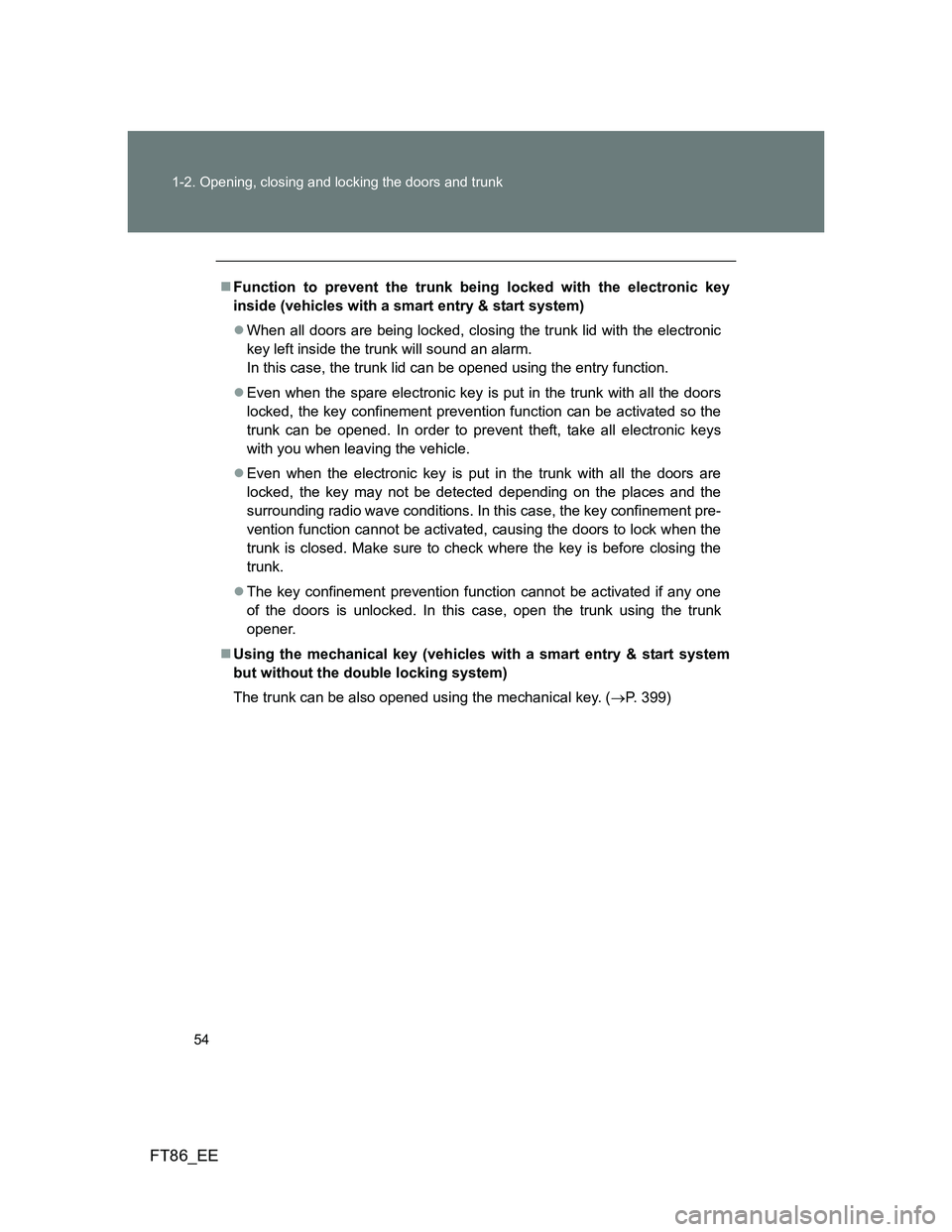
54 1-2. Opening, closing and locking the doors and trunk
FT86_EE
Function to prevent the trunk being locked with the electronic key
inside (vehicles with a smart entry & start system)
When all doors are being locked, closing the trunk lid with the electronic
key left inside the trunk will sound an alarm.
In this case, the trunk lid can be opened using the entry function.
Even when the spare electronic key is put in the trunk with all the doors
locked, the key confinement prevention function can be activated so the
trunk can be opened. In order to prevent theft, take all electronic keys
with you when leaving the vehicle.
Even when the electronic key is put in the trunk with all the doors are
locked, the key may not be detected depending on the places and the
surrounding radio wave conditions. In this case, the key confinement pre-
vention function cannot be activated, causing the doors to lock when the
trunk is closed. Make sure to check where the key is before closing the
trunk.
The key confinement prevention function cannot be activated if any one
of the doors is unlocked. In this case, open the trunk using the trunk
opener.
Using the mechanical key (vehicles with a smart entry & start system
but without the double locking system)
The trunk can be also opened using the mechanical key. (P. 399)
Page 85 of 448
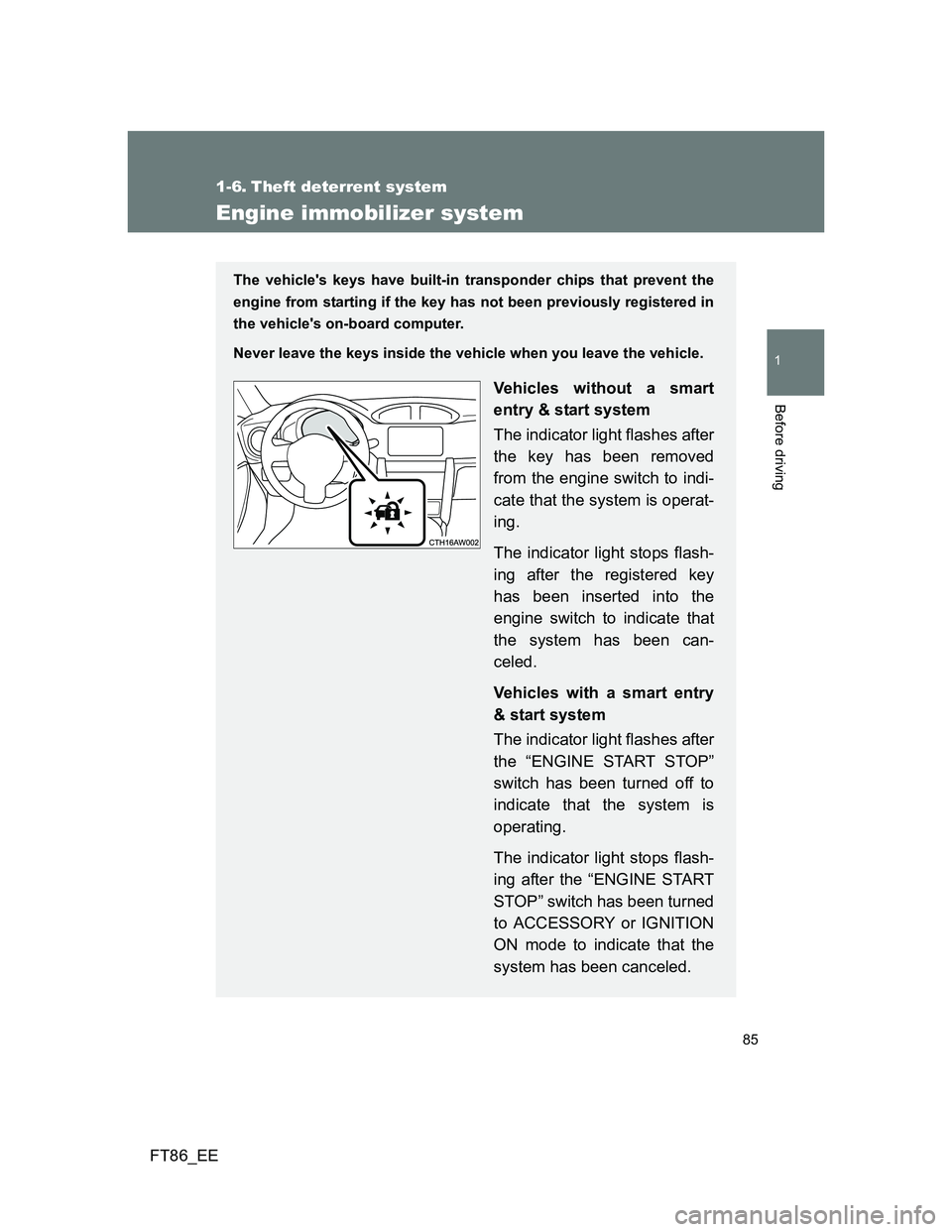
85
1
Before driving
FT86_EE
1-6. Theft deterrent system
Engine immobilizer system
The vehicle's keys have built-in transponder chips that prevent the
engine from starting if the key has not been previously registered in
the vehicle's on-board computer.
Never leave the keys inside the vehicle when you leave the vehicle.
Vehicles without a smart
entry & start system
The indicator light flashes after
the key has been removed
from the engine switch to indi-
cate that the system is operat-
ing.
The indicator light stops flash-
ing after the registered key
has been inserted into the
engine switch to indicate that
the system has been can-
celed.
Vehicles with a smart entry
& start system
The indicator light flashes after
the “ENGINE START STOP”
switch has been turned off to
indicate that the system is
operating.
The indicator light stops flash-
ing after the “ENGINE START
STOP” switch has been turned
to ACCESSORY or IGNITION
ON mode to indicate that the
system has been canceled.
Page 86 of 448
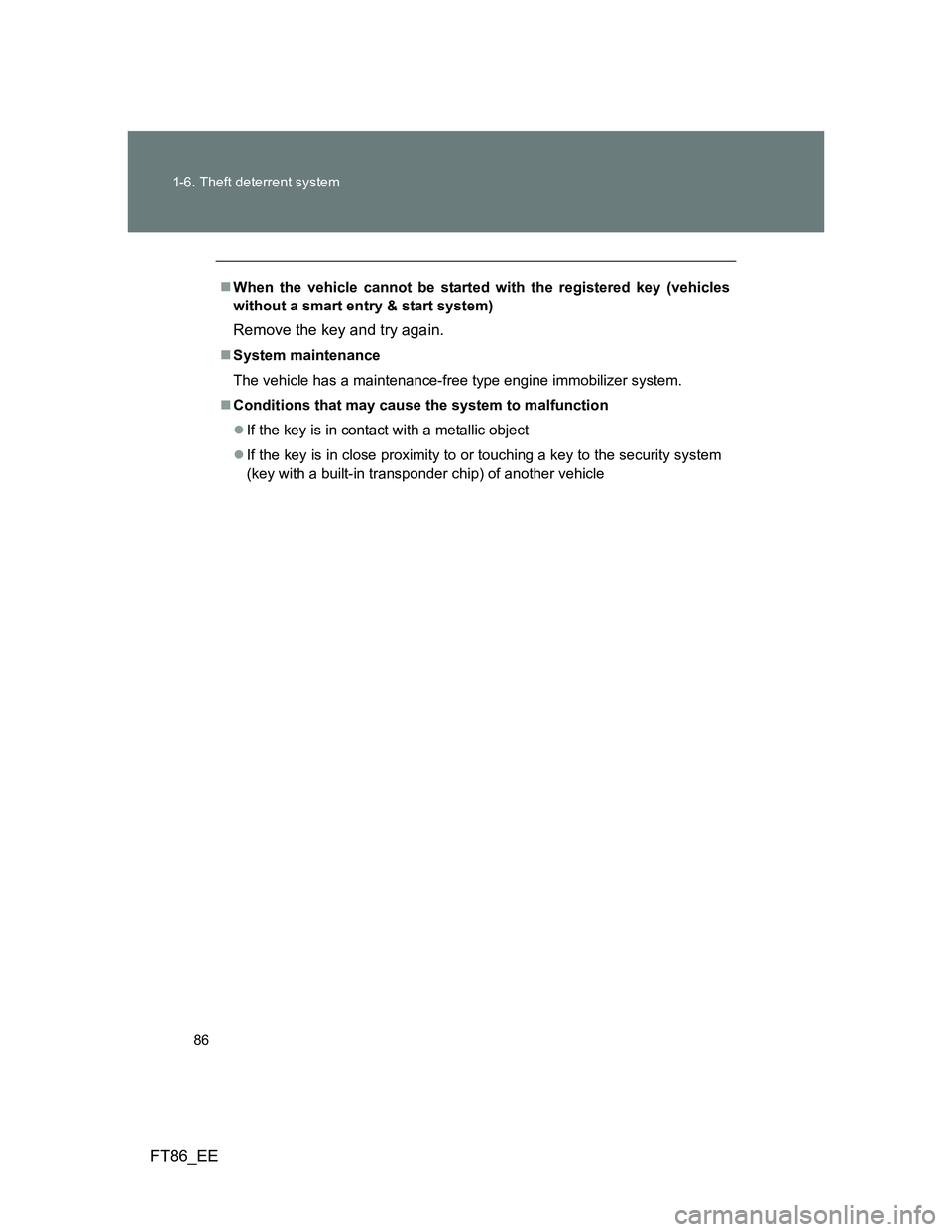
86 1-6. Theft deterrent system
FT86_EE
When the vehicle cannot be started with the registered key (vehicles
without a smart entry & start system)
Remove the key and try again.
System maintenance
The vehicle has a maintenance-free type engine immobilizer system.
Conditions that may cause the system to malfunction
If the key is in contact with a metallic object
If the key is in close proximity to or touching a key to the security system
(key with a built-in transponder chip) of another vehicle
Page 120 of 448
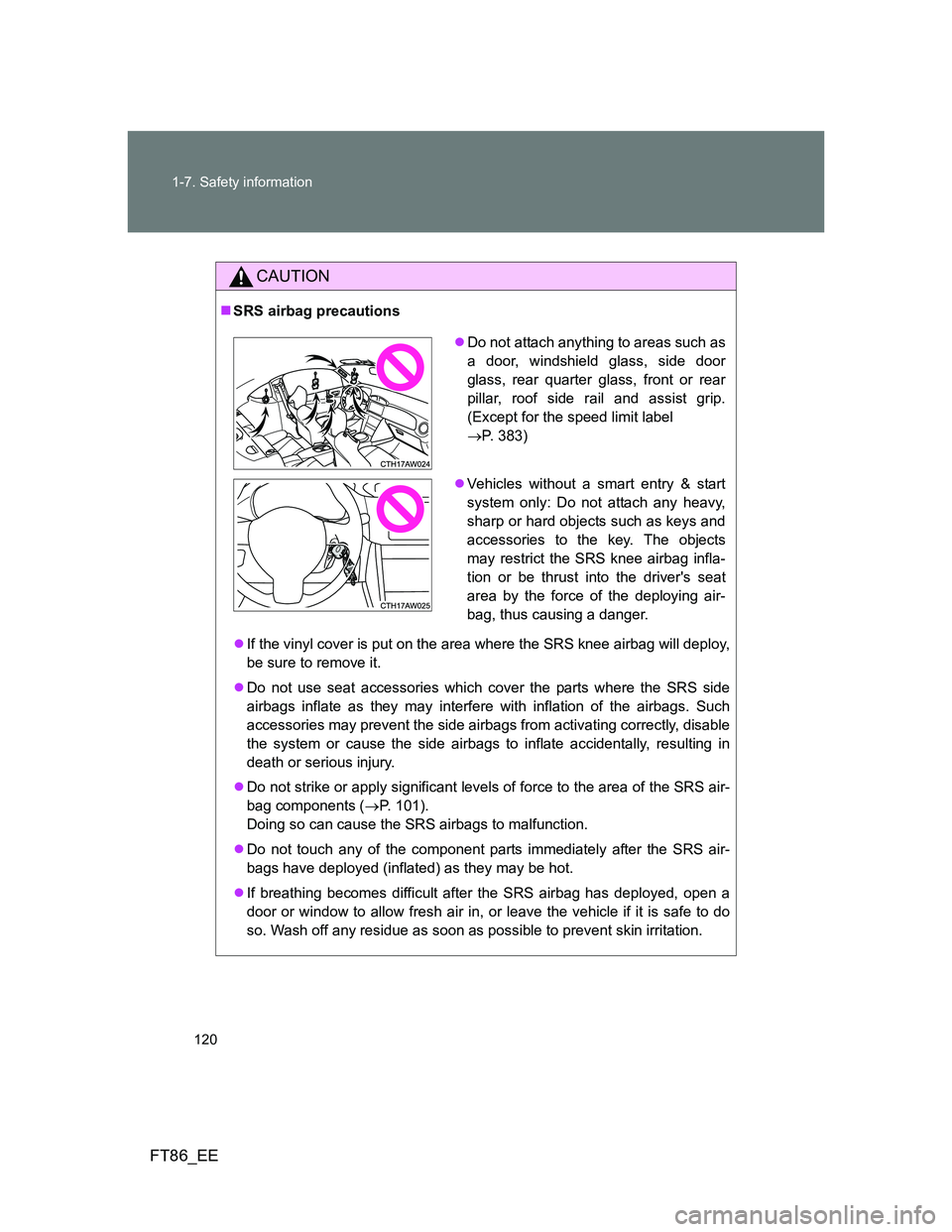
120 1-7. Safety information
FT86_EE
CAUTION
SRS airbag precautions
If the vinyl cover is put on the area where the SRS knee airbag will deploy,
be sure to remove it.
Do not use seat accessories which cover the parts where the SRS side
airbags inflate as they may interfere with inflation of the airbags. Such
accessories may prevent the side airbags from activating correctly, disable
the system or cause the side airbags to inflate accidentally, resulting in
death or serious injury.
Do not strike or apply significant levels of force to the area of the SRS air-
bag components (P. 101).
Doing so can cause the SRS airbags to malfunction.
Do not touch any of the component parts immediately after the SRS air-
bags have deployed (inflated) as they may be hot.
If breathing becomes difficult after the SRS airbag has deployed, open a
door or window to allow fresh air in, or leave the vehicle if it is safe to do
so. Wash off any residue as soon as possible to prevent skin irritation.
Do not attach anything to areas such as
a door, windshield glass, side door
glass, rear quarter glass, front or rear
pillar, roof side rail and assist grip.
(Except for the speed limit label
P. 383)
Vehicles without a smart entry & start
system only: Do not attach any heavy,
sharp or hard objects such as keys and
accessories to the key. The objects
may restrict the SRS knee airbag infla-
tion or be thrust into the driver's seat
area by the force of the deploying air-
bag, thus causing a danger.
Page 128 of 448

128 1-7. Safety information
FT86_EENote
When you use child restraint system on the front passenger seat, you
must turn off the airbag manual on-off switch.
Key of letters inserted in the above table:
U: Suitable for “universal” category child restraint system approved
for the use in this mass group.
L1: Suitable for “TOYOTA DUO+” (9 to 18 kg [20 to 39 lb.]) approved
for the use in this mass group.
L2: Suitable for “TOYOTA KID FIX” (15 to 36 kg [34 to 79 lb.])
approved for the use in this mass group.
L3: Suitable for “TOYOTA G 0+,BABY SAFE PLUS” (up to 13 kg [28
lb.]) approved for the use in this mass group.
L4: Suitable for “TOYOTA G 0+,BABY SAFE PLUS with SEAT BELT
FIXATION, BASE PLATFORM” (up to 13 kg [28 lb.]) approved for
the use in this mass group.
L5: Suitable for “TOYOTA KID” (15 to 36 kg [34 to 79 lb.]) approved
for the use in this mass group.
X: Not suitable seat position for children in this mass group.
The child restraint systems mentioned in the table may not be avail-
able outside of the EU area.
Other child restraint systems different from the systems mentioned in
the table can be used, but the suitability of the systems must be care-
fully checked with the child restraint system manufacturer and
retailer.
Page 130 of 448
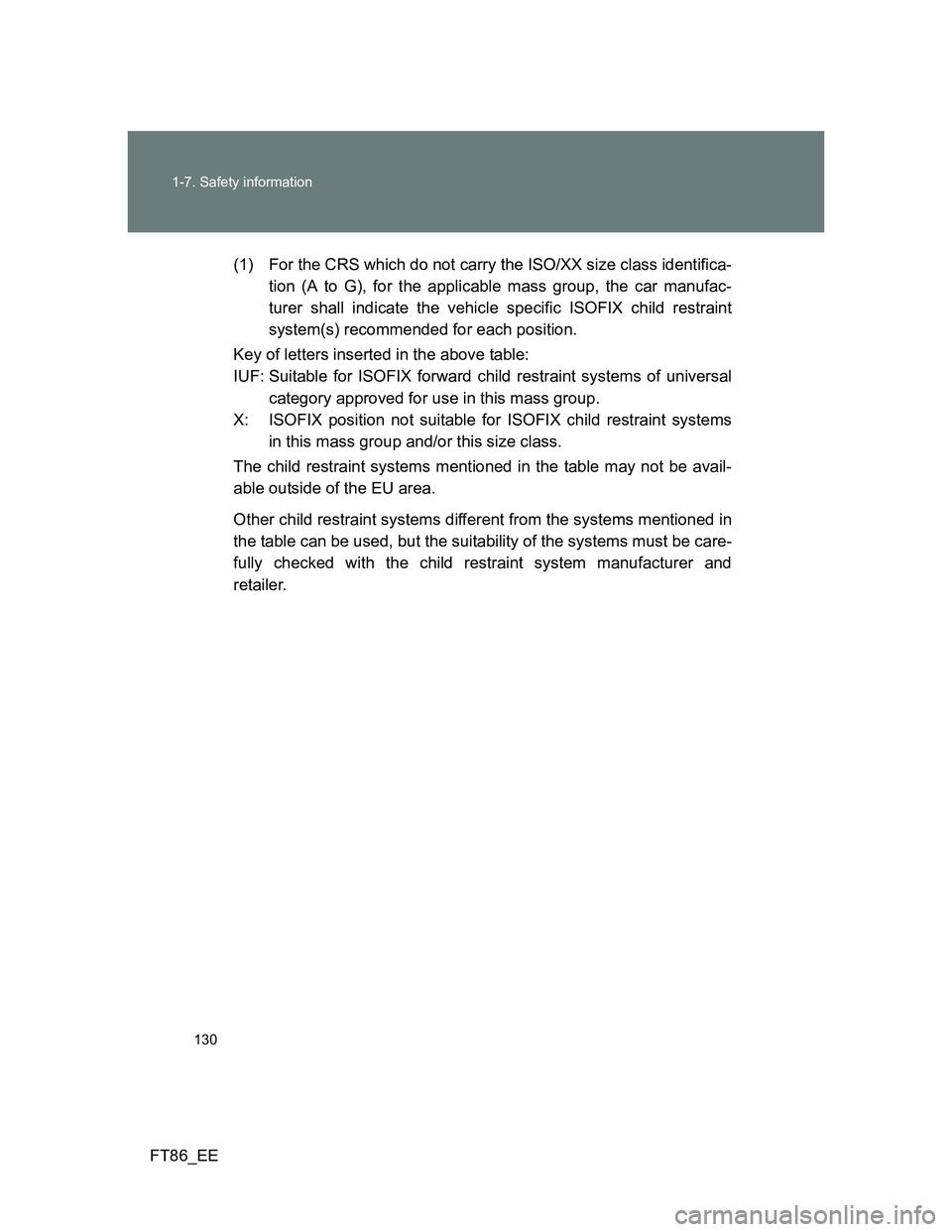
130 1-7. Safety information
FT86_EE(1) For the CRS which do not carry the ISO/XX size class identifica-
tion (A to G), for the applicable mass group, the car manufac-
turer shall indicate the vehicle specific ISOFIX child restraint
system(s) recommended for each position.
Key of letters inserted in the above table:
IUF: Suitable for ISOFIX forward child restraint systems of universal
category approved for use in this mass group.
X: ISOFIX position not suitable for ISOFIX child restraint systems
in this mass group and/or this size class.
The child restraint systems mentioned in the table may not be avail-
able outside of the EU area.
Other child restraint systems different from the systems mentioned in
the table can be used, but the suitability of the systems must be care-
fully checked with the child restraint system manufacturer and
retailer.
Page 149 of 448
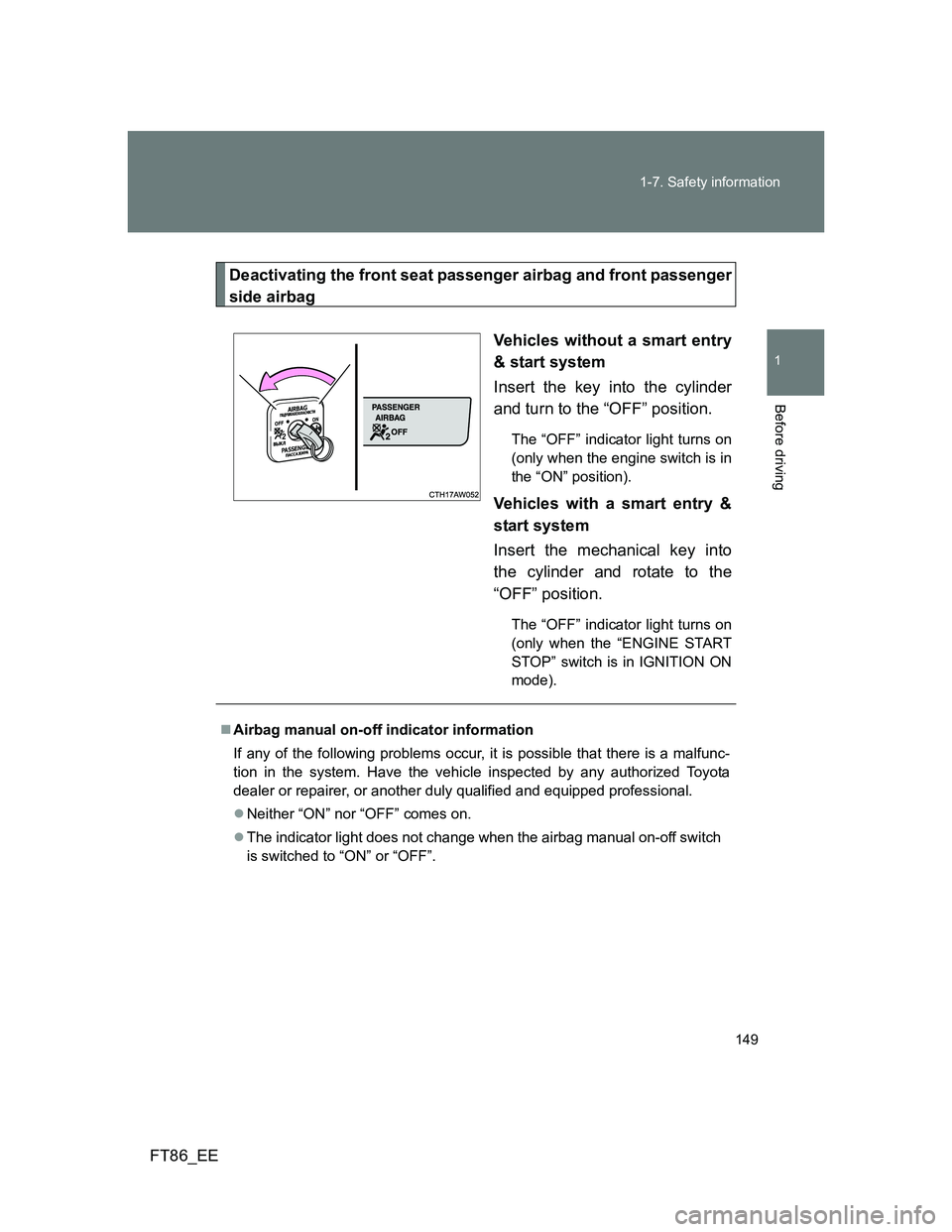
149 1-7. Safety information
1
Before driving
FT86_EE
Deactivating the front seat passenger airbag and front passenger
side airbag
Vehicles without a smart entry
& start system
Insert the key into the cylinder
and turn to the “OFF” position.
The “OFF” indicator light turns on
(only when the engine switch is in
the “ON” position).
Vehicles with a smart entry &
start system
Insert the mechanical key into
the cylinder and rotate to the
“OFF” position.
The “OFF” indicator light turns on
(only when the “ENGINE START
STOP” switch is in IGNITION ON
mode).
Airbag manual on-off indicator information
If any of the following problems occur, it is possible that there is a malfunc-
tion in the system. Have the vehicle inspected by any authorized Toyota
dealer or repairer, or another duly qualified and equipped professional.
Neither “ON” nor “OFF” comes on.
The indicator light does not change when the airbag manual on-off switch
is switched to “ON” or “OFF”.